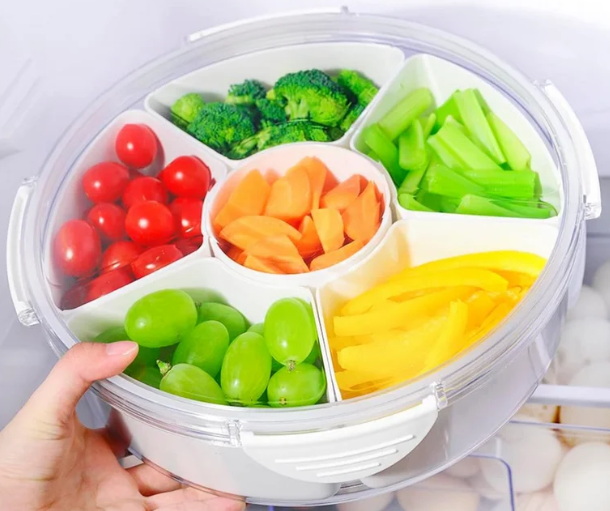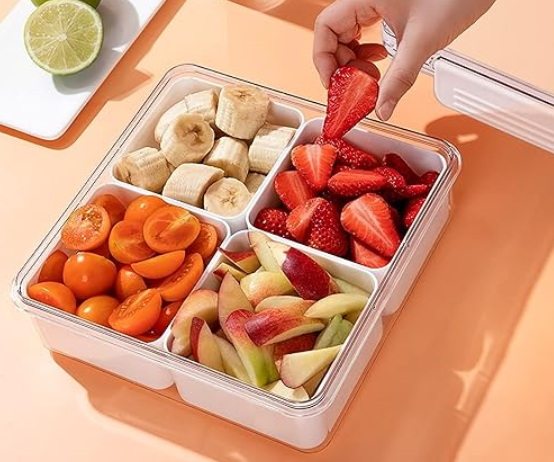
Content Menu
● Introduction to Disposable Veggie Trays
>> Benefits of Using Disposable Veggie Trays
● How Disposable Veggie Trays Work
>> Tips for Using Disposable Veggie Trays
● Types of Disposable Veggie Trays
>> Accessories for Disposable Trays
● Common Uses of Disposable Veggie Trays
● Advanced Uses of Disposable Veggie Trays
>> Enhancing Presentation with Disposable Trays
● Environmental Impact of Disposable Veggie Trays
>> Reducing Waste with Disposable Trays
● Innovative Designs in Disposable Veggie Trays
>> Future Trends in Disposable Veggie Trays
● Conclusion
● FAQ
>> 1. What materials are disposable veggie trays made of?
>> 2. How do disposable veggie trays keep vegetables fresh?
>> 3. Are disposable veggie trays environmentally friendly?
>> 4. Can disposable veggie trays be reused?
>> 5. Where can I purchase disposable veggie trays with lids?
In today's fast-paced world, maintaining the freshness of vegetables is crucial, whether you're a busy homeowner or a professional in the food service industry. One effective tool for achieving this is the disposable veggie tray with lid. These trays are designed to keep vegetables fresh by controlling moisture and preventing contamination. In this article, we will explore how these trays work, their benefits, and how they can be used effectively.

Introduction to Disposable Veggie Trays
Disposable veggie trays with lids are made from materials such as PET (Polyethylene Terephthalate) or PP (Polypropylene), which are durable, lightweight, and easy to clean. They are perfect for indoor and outdoor events, catering services, and even everyday use at home. The lid ensures that the vegetables remain fresh by maintaining a consistent environment inside the tray.
Benefits of Using Disposable Veggie Trays
1. Convenience: These trays are easy to use and require minimal setup. They are ideal for events where quick cleanup is essential.
2. Freshness: The lid helps to maintain humidity and prevent moisture loss, keeping vegetables crisp and fresh.
3. Portability: The trays are lightweight and stackable, making them easy to transport.
How Disposable Veggie Trays Work
The key to keeping vegetables fresh in these trays is controlling the environment inside. Here's how it works:
- Moisture Control: The lid prevents excess moisture from escaping, which helps maintain the natural humidity around the vegetables. This is particularly important for leafy greens and root vegetables.
- Protection from Ethylene Gas: Some vegetables, like apples and bananas, produce ethylene gas as they ripen. This gas can cause other vegetables to ripen faster. The lid helps to contain this gas, slowing down the ripening process.
Tips for Using Disposable Veggie Trays
1. Choose the Right Vegetables: Not all vegetables are suitable for storage in these trays. For example, summer squash and cucumbers prefer good airflow, so they might not be the best candidates.
2. Keep Them Clean: Ensure the tray is clean before use to prevent contamination.
3. Monitor Temperature: Keep the tray away from direct sunlight and heat sources to maintain a consistent temperature.
Types of Disposable Veggie Trays
There are various types of disposable veggie trays available, catering to different needs and preferences:
- Biodegradable Trays: Made from eco-friendly materials, these trays are ideal for those looking to reduce their environmental footprint.
- PET and PP Trays: These are more common and offer durability and affordability.
Accessories for Disposable Trays
Accessories like doilies and paper rolls can enhance the presentation of your vegetables. Additionally, lids made from different materials (such as PET or wood) can provide additional protection and style.

Common Uses of Disposable Veggie Trays
These trays are versatile and can be used in various settings:
- Events and Parties: Perfect for serving crudités or vegetable platters.
- Catering Services: Ideal for transporting and serving vegetables in a professional setting.
- Home Use: Great for storing vegetables in the fridge or for quick snacks.
Advanced Uses of Disposable Veggie Trays
Beyond their basic use, disposable veggie trays can be utilized in more creative ways:
- Gardening: They can be repurposed as mini greenhouses for seedlings or as planters for small herbs.
- Craft Projects: The trays can be used as bases for craft projects, such as making terrariums or decorative planters.
Enhancing Presentation with Disposable Trays
To make your vegetable platter more appealing, consider adding garnishes like fresh herbs or edible flowers. You can also use different colored vegetables to create a visually appealing arrangement.
Environmental Impact of Disposable Veggie Trays
While traditional disposable trays are not biodegradable, there is a growing trend towards more sustainable options. Biodegradable trays made from materials like bamboo or sugarcane are becoming increasingly popular. These options are compostable and reduce waste, making them a more environmentally friendly choice.
Reducing Waste with Disposable Trays
To minimize waste, consider reusing disposable trays if possible. Some trays can be washed and reused several times before they need to be disposed of. Additionally, choosing biodegradable options can significantly reduce environmental impact.
Innovative Designs in Disposable Veggie Trays
Manufacturers are continuously innovating to meet consumer demands for sustainability and functionality. Some trays now come with built-in ventilation systems to improve airflow, which can help prevent moisture buildup and keep vegetables fresh for longer.
Future Trends in Disposable Veggie Trays
As consumers become more environmentally conscious, the demand for eco-friendly disposable products is increasing. Future trends may include more biodegradable materials, compostable packaging, and innovative designs that enhance freshness while reducing waste.
Conclusion
Disposable veggie trays with lids are an excellent way to keep your vegetables fresh while offering convenience and portability. Whether you're hosting an event or simply want to maintain the freshness of your vegetables at home, these trays are a valuable tool. By understanding how they work and using them effectively, you can enjoy crisp, fresh vegetables for longer.

FAQ
Here are some frequently asked questions about disposable veggie trays with lids:
1. What materials are disposable veggie trays made of?
Disposable veggie trays are typically made from materials like PET (Polyethylene Terephthalate) or PP (Polypropylene), which are durable and food-safe.
2. How do disposable veggie trays keep vegetables fresh?
These trays keep vegetables fresh by maintaining humidity and preventing moisture loss. The lid helps to contain ethylene gas produced by some vegetables, slowing down the ripening process.
3. Are disposable veggie trays environmentally friendly?
While traditional PET and PP trays are not biodegradable, there are biodegradable options available for those concerned about environmental impact.
4. Can disposable veggie trays be reused?
While they are designed to be disposable, some trays can be washed and reused. However, this depends on the material and condition of the tray.
5. Where can I purchase disposable veggie trays with lids?
You can find disposable veggie trays with lids at suppliers like Lesui or online retailers like Target.

















